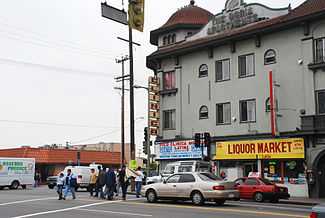John Jones and Doria Deighton-Jones
John Jones (died 1876) and Doria Deighton-Jones (1824-1922) were husband-and-wife landowners and developers in 19th- and early 20th-Century Los Angeles, California. John Jones was president of the Los Angeles Common Council, the governing body of that city, in 1870–71.
Personal
John Jones, a Jew, was born in Poland, then lived in England until he came to the United States and settled in Los Angeles. He was married in 1858 to Doria Deighton, born in Perth, Scotland, on June 6, 1824;[1] the marriage occurred three years after Doria came to Los Angeles from San Francisco. "Some historians posit that Mrs. Jones converted to Judaism prior to her marriage to Jones."[2] In Los Angeles the couple lived in a "large adobe home" adjoining the present site of Olvera Street in the Los Angeles Plaza Historic District.[2] They had three children,[3] including son Mark Gordon and daughters Constance (Simpson) and Caroline A, (Mrs. James B. Lankershim).[4][5]
John died in 1877, and Doria died in her home at 955 South Hill Street on March 24, 1908, at the age of eighty-four. "She is said to have been the oldest white woman resident of the city" at the time of her death."[5]
Business
John Jones was a wholesale grocer and by 1853 the first wholesale liquor dealer in Los Angeles, at the corner of Main and Commercial streets (the Arcadia Block). By 1866, though, he had sold out to Harris Newmark, who had premises next to his.[6][7] As for Doria Deighton-Jones, at the time of her death in 1922, she was known as the "owner of a vast estate in and around Los Angeles," valued at a million dollars.[5]
Public service
Voters in the city's 1st Ward elected John Jones to represent them on the Los Angeles Common Council for a one-year term ending December 11, 1871. Fellow council members chose him as the first Jewish president of the city's governing body during that term.[2][8]
Doria Deighton-Jones was an organizer of the Ladies' Hebrew Benevolent Society in 1870—the city's first philanthropic organization—and served as its treasurer.[2]
Buildings legacy

West Pico Boulevard.
- Olvera Street
Doria Deighton-Jones ordered the construction of the Jones and the Simpson-Jones buildings on the site of the family's adobe house on Olvera Street, which was torn down when Bath Street was widened and made an extension of Main Street. The former structure, built in 1844 by Pedro Seguro, was originally divided into five shops, housing at different times a cigar store, shooting gallery, machine shop, plumbing and tin shops and blacksmitheries. After Olvera Street became a Mexico-themed shopping and restaurant row in 1930, the main entryway was switched to the Olvera side—the entrance to the El Luz del Día restaurant.[3][9][10]
The Simpson-Jones Building, constructed in 1894, has been altered to resemble a Mexican bank from "around 1860." The name honors the Joneses' daughter, Constance Jones Simpson, who inherited the property in 1908.[3][9]
- Alvarado Terrace
In 1902 Doria Jones subdivided her property in Alvarado Terrace, selling the lots for just $10 each but requiring the buyers to erect houses that cost at least $4,000. It was publicized as "The only exclusive Residential Tract in the city. . . No flats, cottages or stores."[4]
- Doria Apartments
The Doria Apartments building at 1600-1604 West Pico Boulevard was built around 1905 by Doria Jones. It was designed in the Mission Revival style by Gotfred Hanson.[11] It is a registered Los Angeles Historic-Cultural Monument.
References and notes
Access to the Los Angeles Times links may require the use of a library card.
- ↑ Graham Deighton Hastie, History of the Deighton Family in Scotland, 2012
- ↑ 2.0 2.1 2.2 2.3 Stephen J. Sass, "Downtown's Jewish L.A.ndmarks," JewishJournal.com, August 9, 2011
- ↑ 3.0 3.1 3.2 PublicArtInLA.com
- ↑ 4.0 4.1 "The Alvarado House Tour Presented by the Los Angeles Conservancy" (1982)
- ↑ 5.0 5.1 5.2 "Pioneer Woman Dies at County Home," Los Angeles Herald, March 25, 1908, page 3
- ↑ Juan José Warner, An Historical Sketch of Los Angeles County, California . . .
- ↑ Harris Newmark, Sixty Years in Southern California, 1853–1913 . . .
- ↑ Chronological Record of Los Angeles City Officials,1850-1938, compiled under direction of Municipal Reference Library, City Hall, Los Angeles (March 1938, reprinted 1966). "Prepared ... as a report on Project No. SA 3123-5703-6077-8121-9900 conducted under the auspices of the Works Progress Administration."
- ↑ 9.0 9.1 Big Orange Landmarks blog, Floyd S. Bariscale: "Plaza Park" — with photographs of the buildings (September 11, 2007).
- ↑ A different version of this story is at "Machine Shop," El Pueblo de Los Angeles Historical Monument.
- ↑ Flickr.com: photograph